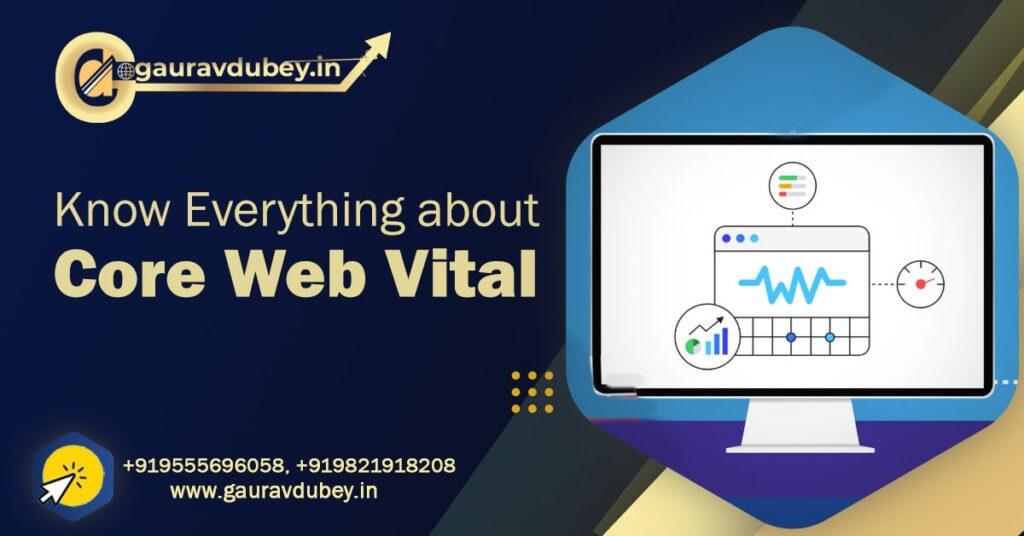What Are Core Web Vitals?
Google introduced Core Web Vitals in May 2020. It is planning to make Core Web Vitals Google official ranking signals. Now let’s understand what these are.
Core Web vitals measure and assess the responsiveness, speed, and visual stability of websites. It offers more opportunities to boost the ranking of web pages.

Core web vitals evaluates user experience which means it measures what results will the users receive, how easily the users can navigate through your website, and how fast the users will be able to interact with your website.
There are three Core Web Vitals metrics:
Largest Contentful Paint (LCP) evaluates how fast the elements of a webpage such as videos, images, animations, and texts can load.
Cumulative Layout Shift (CLS) makes sure that web pages are free from confusing and unexpected movements that might worsen the user experience.
First Input Delay (FID) measures the responsiveness of web pages when users visit the pages for the first time. It also evaluates how fast the browser of the website can show results for users.
How Do We Optimize Core Web Vitals
In our experience, there are 5 ways to improve your Core Web Vitals.
1. Reducing and Optimizing Javascript Execution
When the report for a webpage shows a poor FID score, it means that the page takes time to load for users over 300 milliseconds. In this case, you can consider reducing and optimizing your Javascript execution. It can reduce the time between browser Javascript code execution and page.
It is also important to use a little memory because whenever the site’s code requests the browser, it creates a new memory that stops Javascript and the page becomes slow. Also, in order to reduce the execution, unused Javascripts should be cut down. You can use the code-splitting technique to cut down unused Javascript. It will separate the Javascript bundle (collective files as a bundle to prevent many HTTP requests that are essential to load a page) into smaller pieces.

2. Implement Lazy Loading
It is essential to implement lazy loading when you display images on your site. So that, the UX and core web vitals of the site do not get harmed. Lazy loading helps in loading images on a web page exactly at that time when users scroll down without compromising the speed of loading. Lazy loading also improves the site’s performance and limits bandwidth usage. It improves the site’s SEO and reduces the bounce rate. The issue of poor LCP scores can be addressed by implementing lazy loading.

3. Image Compression and Optimization
The largest elements on a web page are images. So, it is important to optimize images. Optimizing images can make your page lighter as well as can improve the site’s loading speed, UX, LCP score, overall page size, and ranking on search engines.

The images can be compressed with tiny.jpg and as a result, LCP results will be improved. However, compressing an image does not compromise picture quality or resolution.
It is also important to activate Content Delivery Network (CDN) for images. CDN is a network of servers that stores content. The servers are distributed all around the world. As servers are activated in many locations, images can be served from the closest server at a fast speed.
4. Provide proper dimensions for images and embeds
CLS score becomes poor when elements like ads, images, or embeds on a web page are without dimension in the CSS file. Proper width and height of such elements can help the browser to allocate space on the page at the time of loading and the elements can be loaded fast. In case, when elements do not have correct dimensions, the browser cannot understand the exact need for space and thus elements load slowly on the site.
5. Improve server response time
If the server response time is slow, it takes a longer time to receive content from the server and show anything on the screen. It can also negatively influence UX and SEO. Therefore, faster server response time directly improves page load time and LCP.

You can measure the server response time by using Time to First Byte (TTFB). It calculates the time of receiving the first byte of your page’s content by the user’s web browser.

Final Thoughts
It is important to remember that the back end of the website works hand in hand with the front end. Therefore, the back end should be optimized to achieve the best user experience. You can consider visual stability, loading speed, interactivity as well as mobile-friendliness, HTTPS security, and safe browsing not only to improve user experience but also to improve SEO.

